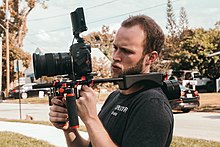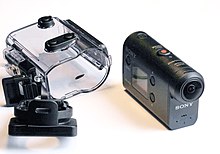Videography

Videography is the process of capturing moving
A videographer is a person who works in the field of videography and/or video production. News broadcasting relies heavily on live television where videographers engage in electronic news gathering (ENG) of local news stories.
Uses

The arrival of computers and the
A
Videography is increasingly connected to the world of
Videography in social science
In social sciences, videography also refers to a specific research method of video analysis, that combines ethnography with the recording of sequences of interaction that are analysed in details with methods developed on the basis of conversation analysis. One of the best known application is in workplace studies.
Videographers
On a set, in a
Typically, videographers are distinguished from cinematographers in that they use digital hard-drive, flash cards or tape drive video cameras vs. 70mm IMAX, 35mm, 16mm or Super 8mm mechanical film cameras. Videographers manage smaller, event-scale productions (commercials, documentaries, legal depositions, live events, short films, training videos, weddings), differing from individualized large production team members. The advent of high definition digital video cameras, however, has blurred this distinction.[2]
Videographers maintain and operate a variety of video camera equipment, sound recording devices, edit footage, and stay up to date with technological advances. With modern video camcorders, professional studio quality videos can be produced at low cost rivaling large studios. Many major studios have stopped using film as a medium due to
See also
- 3D film
- Cinematography
- Camera coverage
- Camera operator
- Camera tracking
- Cinematic techniques
- Digital cinema
- Event videography
- Filmmaking
- Underwater videography
- Video production
- Wedding videography
References
- ^ work.chron.com, videographer
- ^ "unm.edu, The University of New Mexico, Albuquerque, Videographer". Archived from the original on 2018-12-11. Retrieved 2019-07-20.
- ^ Home Studio vs Professional Studio
Further reading
- Knoblauch H, Tuma R (2011) Videography: an interpretive approach to video-recorded micro-social interaction. In: Margolis E., Pauwels L. (eds) The Sage Handbook of Visual Methods. Thousand Oaks, CA: Sage, 414–430.
